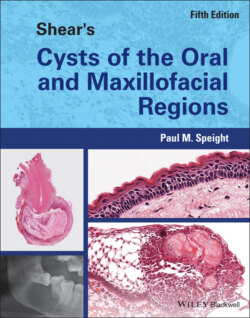Читать книгу Shear's Cysts of the Oral and Maxillofacial Regions - Paul M. Speight - Страница 69
Clinical Presentation
ОглавлениеOver 60% of all inflammatory collateral cysts are paradental cysts involving mandibular third molar teeth with a history of recurrent or persistent pericoronitis, although lesions may be symptomless at presentation. The third molar is always partially or recently erupted and most are impacted. In Craig's (1976 ) series of 48 patients, all cases were associated with a history of pericoronitis, but bony expansion or swelling was not a feature and most lesions were chance findings on extraction of the impacted tooth. Ackermann et al. (1987 ), Fowler and Brannon (1989 ), and Colgan et al. (2002 ) found that all their cases were associated with a partially erupted third molar with a history or presence of pericoronitis. Symptoms of pain or swelling were rarely encountered, although there may be signs of persistent infection. On examination, all lesions are found on the buccal side of the tooth and most are orientated towards the distal aspect. On probing, the cyst lumen is usually found to communicate with the associated periodontal pocket or with the pericoronal space beneath the inflamed operculum. As mentioned previously, a paradental cyst may arise on a second molar when it is the last standing tooth in the mandible. This is rare, but when it occurs the clinical and radiological features are identical to a paradental cyst arising on a third molar (Vedtofte and Praetorius 1989 ; de Sousa et al. 2001 ; Maruyama et al. 2015 ).
In contrast to the paradental cyst, the mandibular buccal bifurcation cyst usually presents with symptoms – most often a complaint of swelling, with pain or tenderness. Stoneman and Worth (1983 ) first reported this lesion as ‘mandibular infected buccal cyst’, and although some cases produced few or no clinical symptoms, they felt that the lesion was characterised by signs of infection, including discomfort, pain, tenderness, and painful occlusion. Rarely, there may be suppuration with formation of a facial abscess that may point (Figure 4.1). Swelling and pain are the clinical features most likely to induce the patient to seek advice.
Pompura et al. (1997 ) reported 32 patients with cysts on mandibular first molars and found that all cases presented with pain or tenderness in the affected area. Only 14 patients (43.7%) were aware of swelling of the cheek, but in the remaining 18 cases intraoral swelling of the alveolus was evident on clinical examination. A foul‐tasting discharge consistent with infection was reported by 20 patients (62.5%). Vedtofte and Praetorius (1989 ) reported 12 cases associated with first or second molars and found that the most common symptoms were pain and swelling associated with discharge of pus. In all cases the cyst lumen communicated with the periodontal pocket on the buccal aspect of the tooth. Philipsen et al. (2004 ) reported that buccal swelling was rarely associated with cysts on the second molar, but is a characteristic feature of lesions on the first molar.
The mandibular buccal bifurcation cyst is always situated on the buccal aspect of the root of the affected tooth and the tooth is usually tilted buccally so that the apices are adjacent to the lingual cortical plate, a feature that is best seen in occlusal radiographs (Figure 4.4) or cone‐beam computed tomography (CBCT). The tooth is always vital, which allows a lateral radicular cyst to be excluded.
Figure 4.1 Young boy with mandibular buccal bifurcation cyst involving a recently erupted mandibular first permanent molar. Infection has extended through the bone, resulting in a facial abscess.
Source: Courtesy of Dr D.W. Stoneman.
With regard to inflammatory collateral cysts presenting at other sites, the clinical features are very similar to the mandibular buccal bifurcation cyst. Morimoto et al. (2004 ) found that all four of their cases on lower premolars presented with swelling and three were also painful. Inflammatory collateral cysts in the globulomaxillary region probably arise in association with the erupting canine and present as an inverted pear‐shaped radiolucency between the incisor and canine teeth, which are vital and show divergent roots. Of the eight cysts in the globulomaxillary region reported by Vedtofte and Holmstrup (1989 ), five were asymptomatic chance findings and three presented with signs of acute infection.
